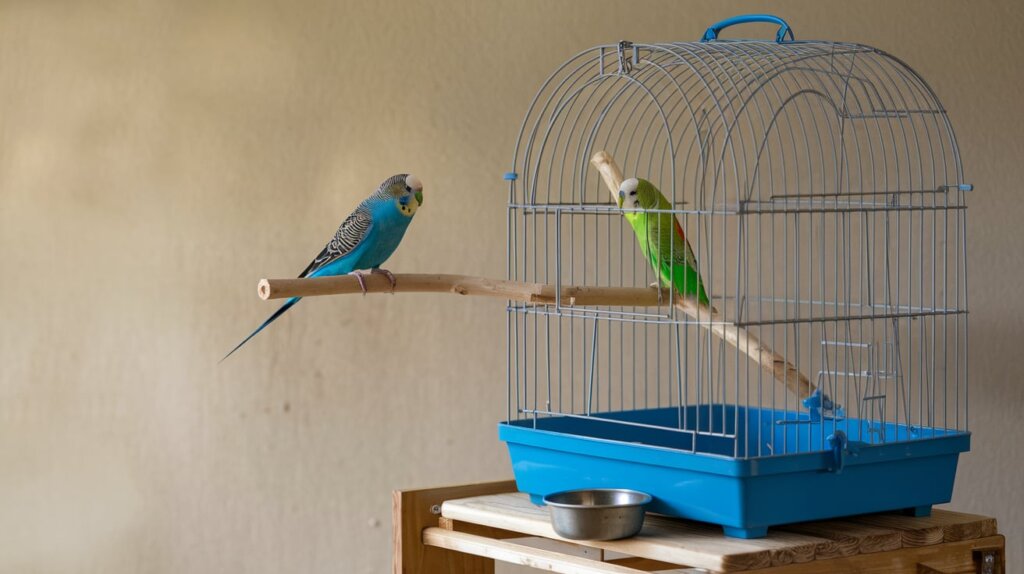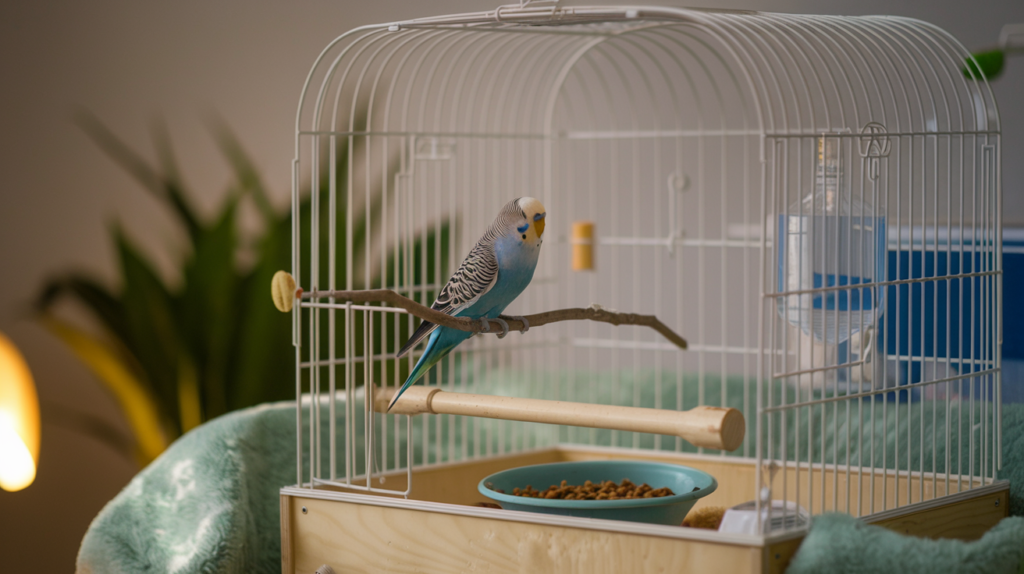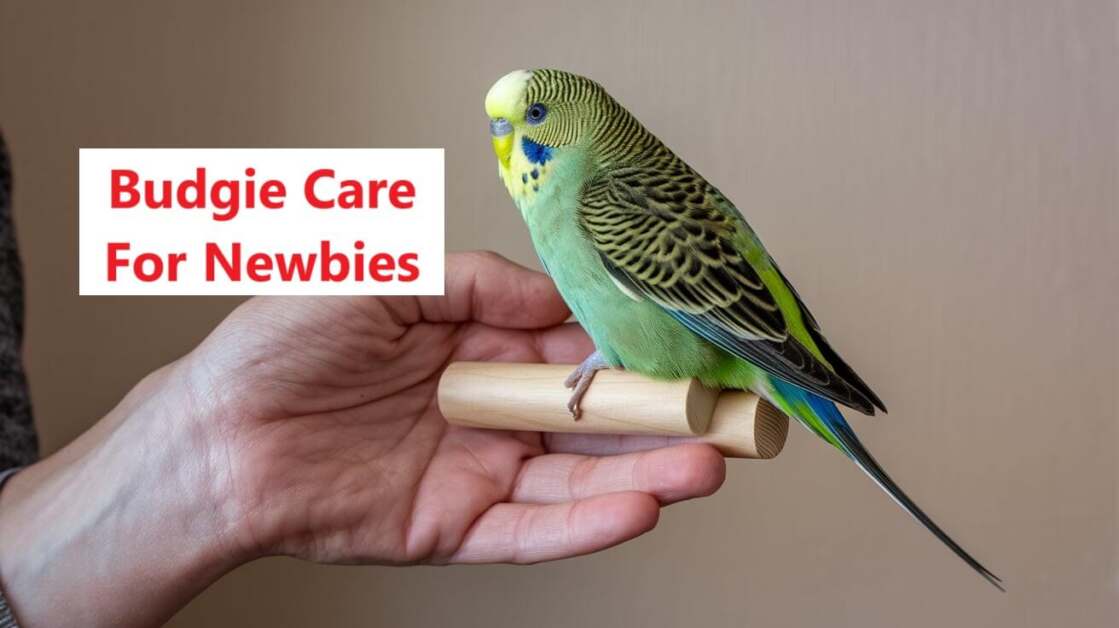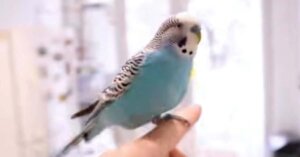Budgie Care For Newbies?
Budgie care involves providing a spacious cage, a balanced diet of pellets, seeds, fruits, and vegetables, daily interaction, and a clean, safe environment to ensure their health and happiness.
Budgies, or parakeets, are lively, intelligent, and colourful birds that make wonderful pets for beginners.
Their small size, cheerful chirping, and engaging personalities make them easy to love. But, like any pet, they need proper care to stay healthy and happy.
In this detailed guide, I’ll share everything you need to know about budgie care, helping you create a loving and safe environment for your new feathered friend.
Choosing Your Budgie

Choosing the right budgie is key for a happy bird experience. This section will guide you through the essential steps.
Learn how to select a healthy bird and decide between a male or female budgie.
1. Selecting A Healthy Bird
A healthy budgie is active and alert. Look for bright eyes and smooth feathers. The bird should be curious about its surroundings.
- Eyes: Clear, bright, and free from discharge.
- Feathers: Smooth, clean, and well-groomed.
- Beak and Feet: Smooth with no cracks or sores.
- Breathing: Quiet and steady, without wheezing.
Observe the budgie’s behavior. A healthy bird is lively and social. Avoid birds that sit quietly for long periods. Ensure the bird is eating and drinking normally.
2. Male Vs. Female Budgies
Male and female budgies have different traits. Males are usually more vocal and social. Females may be quieter but can be more territorial.
| Characteristics | Male Budgies | Female Budgies |
|---|---|---|
| Color of Cere | Blue or purple | Brown or tan |
| Behavior | More talkative, friendly | More reserved, territorial |
| Vocalization | Chirpy, talks more | Quieter, less vocal |
Choose based on your preferences. Both male and female budgies make great pets.
Setting Up Your Budgie’s Home
Welcoming a budgie into your home is exciting. Proper preparation ensures your budgie’s safety and happiness. This section will guide you through setting up a perfect home for your new feathered friend.
1. Choosing The Right Cage
Your budgie’s cage is its sanctuary. Choose a cage that provides ample space. A cage should be at least 18x18x24 inches. Ensure the bars are spaced no more than half an inch apart. This prevents your budgie from escaping or getting stuck.
Look for a cage with horizontal bars. Budgies love to climb. Horizontal bars provide a better grip for their tiny feet. A large door on the cage makes cleaning easier. It also helps when interacting with your budgie.
2. Essential Accessories
Once you have the right cage, you’ll need some accessories. Here are the essentials:
- Perches: Provide multiple perches of different sizes and textures. This helps keep your budgie’s feet healthy.
- Food and Water Bowls: Use sturdy bowls that attach to the cage. Clean them daily to prevent bacteria.
- Toys: Budgies are playful birds. Provide a variety of toys to keep them entertained. Rotate the toys regularly to prevent boredom.
- Bird Bath: Budgies enjoy bathing. Provide a shallow bird bath or mist them with water.
- Cut-Ttlebone: This provides essential minerals and helps keep their beaks trimmed.
Setting up your home properly ensures your budgie’s well-being. Follow these tips for a happy and healthy bird.
What Should You Feed Your Budgie?
Feeding your budgie is crucial for its health and happiness. A balanced diet ensures your budgie stays active and vibrant.
Let’s explore what your budgie should eat and what treats and supplements you can offer.
What Foods Are Best For Budgies
A budgie’s basic diet should consist of seeds and pellets. Seeds are a favorite, but they shouldn’t be the only food. Pellets provide essential vitamins and minerals that seeds lack.
Fresh fruits and vegetables are also vital. Offer small pieces of apple, carrot, and spinach. Provide fresh water daily in a clean bowl.
| Food Type | Examples |
|---|---|
| Seeds | Millet, Canary Seed |
| Pellets | Commercial Bird Pellets |
| Fruits | Apple, Banana |
| Vegetables | Carrot, Spinach |
Treats And Supplements
Treats make your budgie happy and can be used for training. Millet sprays are a great treat but should be given sparingly. Too many treats can lead to obesity.
Supplements are also important. Cuttlebone provides calcium which is crucial for strong bones. Mineral blocks offer additional nutrients. Grit helps with digestion, but don’t overdo it. Always monitor your budgie’s intake of treats and supplements.
- Millet Sprays: Use sparingly as a treat.
- Cuttlebone: Provides essential calcium.
- Mineral Blocks: Supply additional nutrients.
- Grit: Aids in digestion.
What Foods Should You Avoid?
Certain foods are toxic to budgies and must be avoided, including:
- Chocolate
- Avocado
- Caffeine
- Alcohol
- Salty or sugary snacks
Setting Up A Routine
Creating a daily routine for your budgie is essential. It helps your bird feel safe and secure. A consistent schedule keeps your budgie happy and healthy.
1. Daily Care
Daily care for your budgie involves several tasks. These tasks ensure your bird’s well-being.
Here are some daily care tips:
- Feeding: Provide fresh food and water every day. Clean the bowls daily.
- Interaction: Spend at least 30 minutes interacting with your budgie. Talk, sing, or play with your bird.
- Exercise: Allow your budgie to fly outside its cage for exercise. Supervise the bird to ensure safety.
- Cleaning: Remove droppings and food debris from the cage daily. Clean the perches and toys as needed.
2. Weekly And Monthly Tasks
Besides daily care, there are weekly and monthly tasks. These tasks keep your budgie’s environment clean and stimulating.
| Task | Frequency |
|---|---|
| Cage Cleaning | Weekly |
| Bath Time | Weekly |
| Toenail Trimming | Monthly |
| Toy Rotation | Monthly |
Cage cleaning should be thorough. Remove all accessories, wash them, and change the cage liner.
Provide a bath for your budgie. Use a shallow dish of lukewarm water or a bird bath spray. Trim your bird’s toenails carefully. This prevents overgrowth and discomfort.
Rotate your budgie’s toys each month. This keeps the bird engaged and curious. Ensure the toys are safe and appropriate for budgies.
How Can You Bond with Your Budgie?

Socializing your budgie is crucial for a happy and healthy pet. Budgies are social birds that thrive on interaction. Building a bond with your feathered friend takes time and patience.
1. Bonding Techniques
Bonding with your budgie starts with gaining their trust. Sit quietly by their cage and talk softly. Offer treats through the cage bars to show you are friendly. Spend at least 10-15 minutes daily doing this.
- Talk to your budgie regularly in a calm voice.
- Use treats like millet to encourage interaction.
- Play gentle music to create a soothing environment.
Once your budgie is comfortable, introduce your hand slowly. Let your budgie approach your hand at their own pace. Never force interaction as this can scare them.
2. Handling Your Bird
Handling your budgie correctly is essential for their safety and your bond. Begin by letting them step onto your finger. Use a gentle, steady hand.
- Place your finger near their chest.
- Gently press against their breast.
- Encourage them to step up with a soft command like “step up”.
Practice this daily to build confidence and trust. Always handle your budgie in a calm, quiet space.
| Do’s | Don’ts |
|---|---|
| Speak softly | Shout or make loud noises |
| Move slowly | Move suddenly or grab |
| Offer treats | Force interaction |
Consistency is key in socializing your budgie. Be patient and gentle, and you’ll build a strong bond over time.
How Do You Keep Your Budgie Healthy?
Budgies are delightful pets that bring joy to many homes. Keeping your budgie healthy and happy is essential. This section focuses on the health and wellness of your budgie.
Learn about common health issues and signs of a healthy budgie below.
1. Common Health Issues
Budgies may face several health issues. Early detection can help in effective treatment. Below are some common health issues:
- Respiratory problems: Sneezing, coughing, or breathing difficulties.
- Feather plucking: Loss of feathers due to stress or illness.
- Digestive issues: Diarrhea or changes in droppings.
- Beak disorders: Overgrown or misaligned beaks.
- Parasitic infections: Mites and lice affecting skin and feathers.
To know details, read – How Do I Know If My Budgie Is Unhealthy?
2. Signs Of A Healthy Budgie
Knowing the signs of a healthy budgie is crucial. Here’s how to check:
| Aspect | Healthy Signs |
|---|---|
| Feathers | Bright, smooth, and clean. |
| Eyes | Clear and bright. |
| Beak | Clean and well-shaped. |
| Droppings | Firm and green with white part. |
| Behavior | Active, chirping, and playful. |
Maintaining your budgie’s health ensures a happy and long life. Regular check-ups with an avian vet are recommended.
Training And Enrichment
Training and enriching your budgie’s life is essential. It keeps them happy and healthy. A well-trained budgie can be a delightful companion.
Enrichment activities prevent boredom and promote mental stimulation.
Basic Commands
Training your budgie to follow basic commands can be fun. Start with simple commands like “step up” and “step down”.
Use a perch or your finger to guide them. Reward them with treats and praise. Consistency is key. Short, regular training sessions work best.
- Step Up: Teach your budgie to step onto your finger.
- Step Down: Guide them to step off your finger.
- Recall: Train them to fly to you when called.
Use positive reinforcement techniques. Avoid punishment, as it can create fear and mistrust. Patience and gentle handling will yield the best results.
Toys And Activities
Budgies love to play and explore. Providing various toys keeps them engaged. Rotate toys regularly to maintain their interest. Here are some popular toys and activities:
| Toy | Purpose |
|---|---|
| Swings | Promote physical activity and balance. |
| Mirrors | Stimulate social interaction and curiosity. |
| Ladders | Encourage climbing and exercise. |
| Chew Toys | Help maintain beak health and provide mental stimulation. |
Engage your budgie with interactive play. Spend time talking and whistling to them. Allow supervised out-of-cage time for exploration. Create a safe environment for them to fly and play.
- Create a designated play area.
- Remove potential hazards.
- Ensure windows and doors are closed.
By investing in training and enrichment, you ensure a happy and healthy budgie. A happy bird makes for a delightful pet, bringing joy to your home.
Travel And Safety Tips

Traveling with your budgie or ensuring its safety at home requires careful planning. Let’s explore some essential tips to make your budgie’s life both safe and enjoyable.
Safe Travel Tips
Traveling can be stressful for budgies. Follow these tips to keep your budgie safe:
- Use a secure travel cage with proper ventilation.
- Place the cage in a stable position in the car.
- Keep the car temperature comfortable. Avoid extreme heat or cold.
- Cover the cage with a light cloth to reduce stress.
- Carry food and water for long trips. Ensure the cage has non-spill feeders.
Household Hazards
Your home can have hidden dangers for your budgie. Here are some common household hazards to avoid:
| Hazard | Description |
|---|---|
| Open Windows | Budgies can escape through open windows. Always keep them closed. |
| Ceiling Fans | Ceiling fans can harm flying budgies. Turn them off when your budgie is out. |
| Electric Cords | Budgies may chew on cords. Hide or cover them to prevent accidents. |
| Toxic Plants | Many houseplants are toxic to budgies. Remove or keep them out of reach. |
| Non-stick Cookware | Heated non-stick cookware releases fumes harmful to budgies. Avoid using them around your bird. |
Frequently Asked Questions About Budgie Care for Newbies
1. How can I tell if my budgie is stressed?
A stressed budgie may show signs like heavy breathing, fluffed feathers, or hiding in its cage. Other signs include loss of appetite, aggression, or excessive vocalization.
2. Can budgies recognize their owners?
Yes, budgies can recognize their owners by voice, appearance, and behaviour. With consistent interaction, they can form strong bonds and may respond to their name.
3. How often should I let my budgie out of its cage?
Allow your budgie out of its cage daily for at least 1-2 hours. This time helps them exercise, explore, and interact with you, improving their physical and mental health.
4. What should I do if my budgie escapes?
If your budgie escapes, stay calm and close all doors and windows. Use a treat or their favorite toy to coax them back. A familiar voice can help guide them to safety.
5. How can I keep my budgie entertained when I’m not home?
Provide toys, mirrors, and foraging activities in their cage. Leave a radio or soft music on for background noise. Rotate toys regularly to keep them engaged.
Sum Up
Budgie care may feel overwhelming at first, but it’s a rewarding journey. By providing the right cage, a balanced diet, regular interaction, and a safe environment, your budgie will thrive. Their cheerful chirps and playful antics will fill your home with happiness.
If this guide helped you, share it with other bird lovers to help them care for their budgies too.
Read more articles
- How to Care for a Starved Budgie?
- How To Take Care Of Pregnant Budgie?
- How to Warm Up a Cold Budgie?
Hello Dear, I'm Poli Kolymnia, owner of many birds (including budgies).
With a deep passion for these feathered companions, I'm here to share my expertise and extensive knowledge on birds care.
My articles cover essential topics like diet, housing, care, and health, providing practical tips to help you create a happy and thriving environment for your birds.







